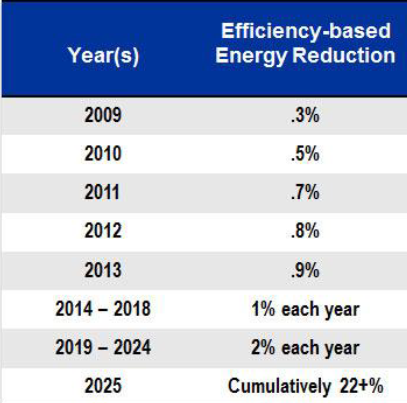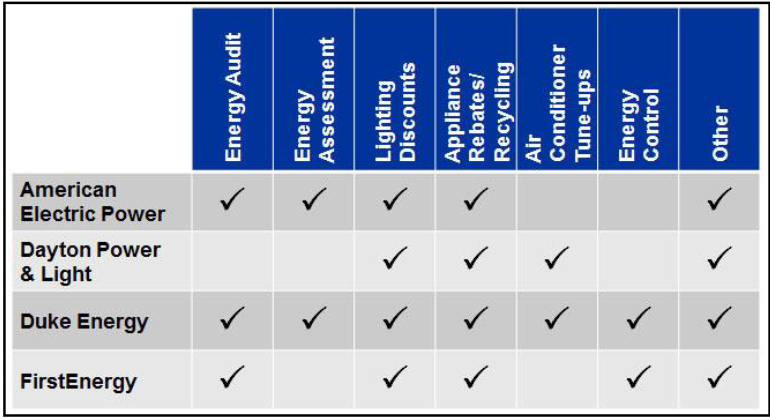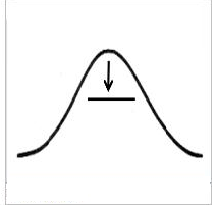
Before
The Ohio Senate
Public Utilities Committee
Testimony Regarding Senate Bill 58
Presented by:
Wilson Gonzalez
Senior Energy Policy Advisor
Office of the Ohio Consumers’ Counsel
April 9, 2013
Good morning Chairman Seitz, Ranking Member Gentile and members of the Public Utilities Committee. I am Wilson Gonzalez, the Senior Energy Policy Advisor at the Office of the Ohio Consumers’ Counsel (OCC). I have worked as an economist in the energy industry for more than 25 years, having worked at the Connecticut Energy Office, Columbia Gas, and American Electric Power prior to joining OCC. Thank you for inviting OCC to testify regarding the energy efficiency and peak demand reduction provisions in the placeholder legislation, Senate Bill 58 (SB 58).
There are two ways Ohioans can save money on their energy bills—by reducing the rates that utilities charge them and by reducing their energy use. Both ways work. But it’s difficult to reduce the utilities’ rates. So it’s all the more important for consumers to take charge of their utility bills by reducing their energy usage.
In general, OCC supports energy efficiency and peak demand reduction programs as they provide opportunities for consumers to control their energy usage and save money on their utility bills. Energy efficiency and peak demand reduction programs are the least cost energy resources available to consumers. Energy efficiency and peak demand reduction efforts therefore are an important tool to help reduce energy costs today and into the future. In my testimony, I will describe the costs and benefits of these programs, as well as the consumer protections that exist in law today.
ENERGY EFFICIENCY
Energy efficiency can be defined as using less energy to provide the same service, be it lighting, heat, cooling, mechanical work, etc. It has been coined by some as a “negawatt,” or the “fifth fuel,” after fossil fuels and renewables.
Ohio law includes an Energy Efficiency Standard (ORC 4928.66), which requires electric distribution utilities to develop programs to achieve certain energy efficiency savings each year through 2025.

The law allows utilities to recover the costs of these programs through a non-bypassable charge on customers’ bills. This means that all customers pay for energy efficiency programs, and all customers are eligible to participate in the utility programs.
The law enables the PUCO to assess a penalty on utilities that fail to comply with the efficiency standard. Utilities are not allowed to charge customers for the cost of the penalty payment. The law also provides flexibility to “mercantile” (large commercial and industrial) customers, allowing them to meet the energy efficiency standard through their own programs (opting out of the utilities’ portfolio of programs). In 2012, the Ohio General Assembly amended the law with SB 315 to allow certain types of cogeneration facilities to qualify as an energy efficiency resource. This additional resource provides utilities and industrial customers with increased flexibility in meeting annual benchmarks in the energy efficiency resource standard.
Each Ohio utility provides consumers with a portfolio of energy efficiency programs to achieve the required savings. Some of these programs are listed in Figure 2.

PEAK DEMAND REDUCTION
There is a separate provision in Ohio law that requires peak demand reduction. This refers to reducing the maximum instantaneous load or the maximum average load over a designated interval of time.

For example, on the hottest days of the year the demand for electricity is at its peak. Meeting this peak demand increases the cost of electricity for all consumers since additional capacity has to be procured and less efficient plants are called into service.
To keep energy prices lower and reduce the need to procure capacity and more expensive peak energy, efforts can be made to reduce these energy peaks. Ohio law requires a 1% reduction of utility peak load in 2009, and .75% peak demand reduction each subsequent year through 2018.
CONSUMER COSTS AND BENEFITS OF ENERGY EFFICIENCY AND PEAK DEMAND REDUCTION PROGRAMS
Energy efficiency and peak demand reduction programs cost money. But these programs also financially benefit consumers. Utilities’ energy efficiency program portfolios must pass an economic cost-benefit test.1 This test ensures that the cost of energy efficiency (the “negawatt” or “fifth fuel”) is less than what it would otherwise cost to generate and deliver that electricity.
In 2011, electric utility program cost-benefit ratios ranged from 1.7 to 4.2 (according to filed utility Compliance Reports).2 This means Ohio consumers saved $1.70 – $4.20 on every dollar spent on energy efficiency. That’s a good return on the investment.
Additionally, the law allows the PUCO to amend the annual benchmarks if the utility cannot “reasonably achieve the benchmarks due to regulatory, economic, or technological reasons beyond its reasonable control.”3
COSTS
Utilities may charge customers for the costs resulting from their energy efficiency programs that are approved by the PUCO. But the costs must be prudently incurred in order for utilities to charge customers. These costs could include the administration, marketing, and delivery of the program, other customer and shareholder incentives, and lost distribution revenues among other potential costs.
Utilities collect these costs from their customers through a “rider” on customer bills. The level of the rider is different for residential, commercial, and industrial customers. The riders also vary utility by utility. The energy efficiency rider costs a typical residential customer (using 750 kWh a month) between $1.74 – $3.91 each month depending on the utility. The monthly electric bill for that same customer ranges from $91 to $111.4 But again, the programs are required to save customers more money than they cost customers.
Additionally, the law allows the PUCO to amend the annual benchmarks if the utility cannot “reasonably achieve the benchmarks due to regulatory, economic, or technological reasons beyond its reasonable control.”5
BENEFITS
The law requires energy efficiency and peak demand reduction programs to benefit consumers; otherwise, utilities would not need to comply with the standards. There are both direct and indirect consumer benefits. Consumers can obtain direct benefits by participating in a utilities’ energy efficiency program. By installing more efficient technologies (light bulbs, refrigerators, washers, dryers, etc.), improving a home’s efficiency with more insulation, or using other techniques, consumers can use less electricity and obtain direct savings on their energy bills.
Consumers, both those who participate in a utilities’ program and those who choose not to, will also receive indirect benefits from energy efficiency. Energy efficiency and peak demand reductions can lower the wholesale cost of capacity, energy and ancillary costs by adding more low cost resources into the market.
Energy efficiency and demand reduction can also postpone the need to build or to upgrade transmission and distribution lines, and avoid the need to purchase more expensive generation capacity.
QUESTIONS THAT HAVE COME BEFORE THE COMMITTEE AND CONSUMER RESPONSES
1. Why does Ohio need an energy efficiency standard when the competitive market should provide energy efficiency?
Many cost-effective energy efficiency opportunities would be missed if Ohio relied solely upon the market. There are several market barriers to energy efficiency including:6
* Limited availability of energy-efficient products;
* Lack of consumer awareness of the products and their benefits;
* Imperfect information;
* Resistance to new products in general;
* Over-emphasis on upfront cost versus the cost to operate the product over its lifetime;
* Split incentives (renter/landlord etc.); and
* Market prices that may not reflect the full cost of energy to society. Such ‘market barriers’ suggest a role for regulatory intervention to encourage customers to become more energy efficient.
2. Should the energy efficiency standard have a cost cap?
Energy efficiency already has an effective 0% cost cap: the utility portfolio of energy efficiency programs must, by PUCO rules, be cheaper than generating electricity.7 There is a thorough process in energy efficiency cases at the PUCO to ensure that energy efficiency costs are reasonable.
3. In 2019, the energy efficiency benchmark increases to 2% per year. Is this level of energy savings reasonable?
Each of Ohio’s electric distribution utilities has filed a technical, economic, and achievable-potential study of energy efficiency with the PUCO.8 Each of their studies show that there is enough cost-effective energy efficiency to meet Ohio’s energy efficiency standards for several years. These studies are updated every three years.
Ohio law and rules contain consumer protections if utilities are unable to reasonably achieve 2% annual energy efficiency savings. The protections include:
a) The PUCO can modify the benchmarks.9
b) Savings can be banked in early years to help comply with the standards in later years.
c) Utility energy efficiency portfolios must be cost-effective10
d) Cogeneration and Combined Heat and Power now qualify as energy efficiency.11
e) Transmission and distribution upgrades can count as energy efficiency.12
The PUCO and utilities have many options to manage the benchmarks through 2025.
4. Should the utilities be required to bid their energy efficiency in the PJM Base Residual Capacity Auction (auction) to lower Ohio consumers’ electricity costs?
Bidding energy efficiency savings and peak demand reduction into the PJM auction can reduce customers’ bills in two ways:
- PJM pays utilities for energy efficiency that is accepted into the auction, and those payments reduce the costs that customers pay for energy efficiency programs. For example, FirstEnergy bid in 36 MW in the 2015/2016 auction and will receive a payment of $4.7 million from PJM for this energy efficiency. AEP Ohio bid in 202 megawatts in the same auction and will receive $10 million. The utilities will use this money to reduce the cost that customers pay for their energy efficiency programs.
- The energy efficiency and peak demand megawatts that are accepted into the auction can lower customers’ electricity prices (by lowering the PJM auction capacity prices).
A recent PUCO Order requires FirstEnergy to bid 75% of its energy efficiency capacity into the PJM Auction.13 UBS Investment Research estimates that adding 150 MW of new supply to the auction will lower PJM’s Capacity Cost at the next Auction by $1.10/MW-day which is approximately a $13 million savings for customers each year.14
5. How should electricity savings be defined?
Defining electricity savings is not a trivial exercise, and can impact how beneficial energy efficiency is for consumers. The PUCO has a draft Technical Reference Manual that is 397 pages long and that borrows from over 30 years of energy efficiency industry knowledge. There currently appear to be two savings standards in Ohio: one for customers of direct utility programs and one for self-direct mercantile customers. Much debate and many legal pleadings have taken place since the passage of SB 221 on this savings issue, and I will not revisit those debates here.
I will simply make a common sense recommendation to the Committee. If the legislature decides to define energy savings in the law, Ohio’s definition should be consistent with PJM’s (as defined in PJM Manual 18B).15 It is essential that Ohio’s definition of energy savings be consistent with PJM’s requirements so that our savings can contribute to lowering electricity prices (by being bid into the PJM capacity auction).
6. Do the changes since 2009 affect the need for Ohio’s energy efficiency resource standard?
A legislative change is not needed because the law allows the PUCO to modify the standard if necessary:
- Natural gas supplies have increased (shale gas) and wholesale electricity prices have decreased. The existing law, rules, and PUCO Orders allow the PUCO to factor the lower natural gas prices into its consideration of utility energy efficiency plans. This protects consumers from “un-economical energy efficiency.”
- Ohio utilities have transitioned (or are transitioning) to purchasing 100% of their electric generation through the wholesale market. Customers will be charged a price for electric generation that is based 100% on the market price of electricity. Reducing consumer demand and adding supply to the market by bidding in energy efficiency can help reduce electricity prices.16
CONCLUSION
OCC appreciates the opportunity to provide the Senate Public Utilities Committee with an overview of Ohio’s energy efficiency and peak demand reduction laws. The existing law and PUCO rules and Orders, contain many consumer and utility protections that provide the PUCO with flexibility in addressing changes in the electricity market. I would be happy to answer any questions at this time.
1 OAC 4901:1-39-01(F) defines “cost-effectiveness” as the “Total Resource Cost Test.” OAC 4901:1-39-04 (B) states that the utility energy efficiency and peak demand reduction portfolio must be cost-effective.
2 FirstEnergy Case No. 12-1533 et al –EL-EEC, Duke Case No. 12-1477-EL-EEC, Dayton Power and Light Case No. 12-1420-EL-POR, and American Electric Power Case No. 12-1537-EL-EEC.
3 ORC 4928.66 (A)(2)(b)
4 March 2013 PUCO Electric Rate Survey.
5 ORC 4928.66 (A)(2)(b)
6 See reference section of “Overcoming Market Barriers and Using Market Forces to Advance Energy Efficiency,” March 2013, American Council for an Energy Efficient Economy. Http://www.cleanenergyfinancecenter.org/wp-content/uploads/e136.pdf.
7 See OAC 4901:1-39-01(F) and OAC 4901:1-39-04(B). Also, if a utilities program portfolio is not cost-effective, Total Resource Cost <0, by definition there are no net shared-savings.
8 OAC 4901:1-39-03(A).
9 ORC 4928.66 (A)(2)(b)
10 OAC 4901:1-39-01(F) and OAC 4901:1-39-04(B).
11 ORC 4928.66(A)(1)(a).
12 ORC 4928.66(A)(2)(d).
13 Opinion and Order in Case No. 12-2190-EL-POR, pages 20-21 (3/20/2013).
14 “PUCO Orders Energy Efficiency Program to Tap Into PJM Capacity Prices,” UBS Investment Research, March 26, 2013. A $1.10/MW-day savings multiplied by the approximate 32,000 MWs in Ohio generates an estimated $13 million per year in state savings from the energy efficiency price effect.
15 PJM Manual 18B: Energy Efficiency Measurement & Verification, March 1, 2010. In Section 8.1 Baseline Requirements for All EE Resources, it states “For projects in which equipment (whether failed or not) is replaced by a more efficient equivalent or by an alternative strategy for delivering comparable output, the Baseline Condition shall be the nameplate rating of the equipment meeting the level of efficiency required by applicable State code, Federal product efficiency standard, or standard practice, whichever is most stringent, in place at the time of installation, as known at the time of commitment. If there is no applicable State code or federal standard, then standard practice shall be used as the basis for establishing Baseline Conditions and shall be documented in the M&V Plan.”
16 Especially in a wholesale market that exhibits market concentration. See “State of the Market Report for PJM 2012,” Monitoring Analytics, LLC, Independent Market Monitor for PJM, 3/14/2013, pages 130-131.
